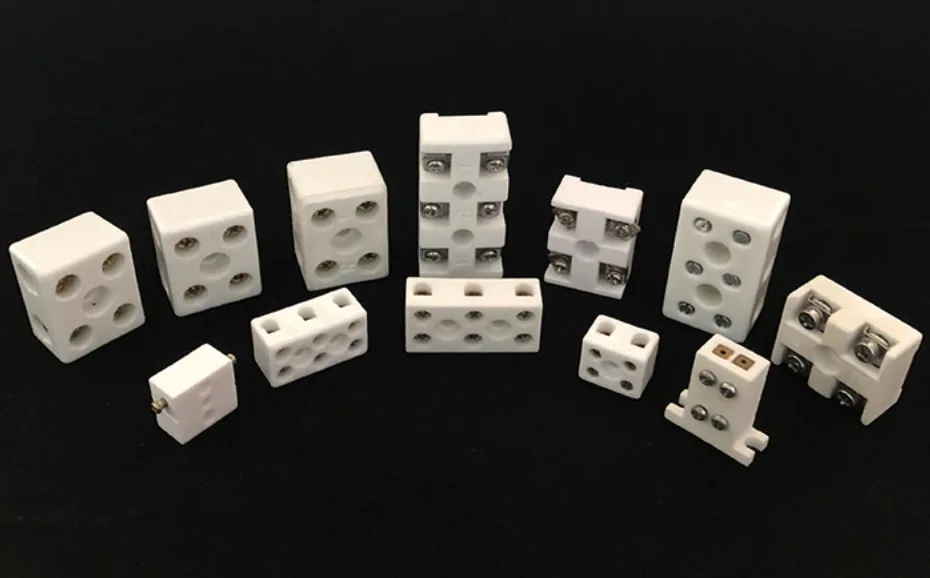Selecting the appropriate ceramic terminal block for high-temperature electrical applications requires understanding critical specifications, environmental demands, and long-term performance requirements. Ceramic terminal blocks offer superior temperature resistance up to 800°C compared to plastic alternatives limited to 105°C, making them essential for industrial furnaces, solar installations, and advanced manufacturing systems. This comprehensive guide provides electrical engineers, purchasing managers, and maintenance technicians with the technical knowledge and decision-making framework needed to confidently specify ceramic terminal blocks that deliver reliable performance while optimizing total cost of ownership.
The global terminal block market continues expanding, driven by renewable energy growth, industrial automation advances, and increasingly stringent fire safety regulations. Ceramic terminal blocks represent the premium segment, offering unmatched thermal performance, electrical isolation, and mechanical durability in demanding environments where plastic alternatives fail catastrophically.
Understanding ceramic terminal block fundamentals

Ceramic terminal blocks utilize high-grade porcelain or steatite ceramic bodies to provide electrical isolation and mechanical support for wire connections in extreme temperature environments. Unlike their plastic counterparts, ceramic blocks maintain structural integrity and electrical performance from -40°C to 800°C, making them indispensable for applications involving furnaces, kilns, heating elements, and high-temperature process equipment.
The ceramic body typically consists of either porcelain (alumino-silicate) or steatite (magnesium silicate) compositions. Standard porcelain blocks handle temperatures to 250°C and offer cost-effective solutions for moderate heat applications. Steatite ceramic blocks excel in extreme conditions, withstanding continuous operation at 600°C with peaks to 800°C while maintaining insulation resistance exceeding 100 MΩ. The zero-porosity steatite construction prevents moisture absorption and chemical infiltration, ensuring consistent performance over decades of service.
Terminal hardware commonly employs brass (CuZn40Pb2 grade) or nickel-plated materials selected for thermal expansion matching and corrosion resistance. Mounting hardware utilizes stainless steel (AISI 304) to prevent galvanic corrosion and maintain mechanical integrity through thermal cycling.
Critical electrical specifications and ratings
Proper ceramic terminal block selection begins with electrical requirements verification, encompassing voltage ratings, current capacity, and insulation characteristics essential for safe, reliable operation.
Voltage ratings typically range from 380V for basic industrial applications to 1000V+ for high-voltage process equipment. Standard industrial installations commonly require 600V blocks, while specialized applications may demand 1500V ratings. The dielectric strength specification, typically exceeding 15 kV/mm for high-grade ceramics, ensures breakdown protection under transient voltage conditions.
Current ratings span from 5A for control circuits to 100A for power distribution applications. Engineers should specify current ratings at minimum 150% of expected maximum load to account for temperature derating and provide safety margin. Current capacity decreases approximately 20% at elevated temperatures, requiring careful calculation for high-heat environments.
Insulation resistance performance distinguishes ceramic blocks from plastic alternatives. Quality ceramic blocks maintain resistance exceeding 190-300 MΩ at room temperature, degrading minimally to 100+ MΩ at 400°C. This exceptional insulation stability prevents leakage currents and maintains electrical isolation integrity throughout the operating temperature range.
Wire gauge compatibility requires verification against specific terminal block designs. Most ceramic blocks accommodate 0.5-25mm² wire ranges (approximately 20-8 AWG), with larger blocks handling up to 35mm² conductors. Multiple wire insertion capability allows connecting two wires per terminal in certain designs, providing installation flexibility.
| СПЕЦИФІКАЦІЯ | МОДЕЛЬ | ДОВЖИНА | ШИРИНА | ВИСОТА | ДІАПАЗОН ДРОТОВОГО ЗВ'ЯЗКУ |
|---|---|---|---|---|---|
| 1 In 1 Out 10A | CTB1110 | 19 мм | 10 мм | 15 мм | 0,5-2,5 мм2 |
| 1 In 1 Out 30A | CTB1130 | 18 мм | 14 мм | 18 мм | 0,5-6 мм2 |
| 2 In 2 Out 10A | CTB2210 | 20,7 мм | 18,9 мм | 13,9 мм | 0,5-2,5 мм2 |
| 2 In 2 Out 15A | CTB2215 | 28,4 мм | 20,4 мм | 16.3 мм | 0,5-4 мм2 |
| 2 In 2 Out 30A | CTB2230 | 31 мм | 27 мм | 18,9 мм | 1,5-6 мм2 |
| 2 In 2 Out 60A | CTB2260 | 38,7 мм | 31 мм | 22,7 мм | 2,5-16 мм2 |
| 2 In 2 Out 100A | CTB22100 | 41.1 мм | 30,2 мм | 25,85 мм | 6-25 мм2 |
| 3 In 3 Out 10A | CTB3310 | 31 мм | 20 мм | 14,3 мм | 0,5-2,5 мм2 |
| 3 In 3 Out 15A | CTB3315 | 35,5 мм | 20,3 мм | 20,2 мм | 0,5-4 мм2 |
| 3 In 3 Out 30A | CTB3330 | 46.2 мм | 26.4 мм | 19,2 мм | 1,5-6 мм2 |
| 4 In 4 Out 30A | CTB4430 | 57 мм | 25 мм | 18,8 мм | 1,5-6 мм2 |
| 5 In 5 Out 15A | CTB5515 | 50 мм | 22 мм | 13 мм | 0,5-2,5 мм2 |
| 6 In 6 Out 15A | CTB6615 | 56,6 мм | 21 мм | 13 мм | 0,5-2,5 мм2 |
| 8 In 8 Out 15A | CTB8815 | 68 мм | 21 мм | 13 мм | 0,5-2,5 мм2 |
| 10 In 10 Out 15A | CTB101015 | 88 мм | 18 мм | 15 мм | 0,5-3,5 мм2 |
Temperature performance and material considerations

Temperature specifications represent the most critical selection criterion for ceramic terminal blocks, directly impacting material choice, performance characteristics, and application suitability.
Operating temperature ranges vary significantly by ceramic composition. Standard porcelain blocks (C111 grade) handle continuous operation to 200°C with intermittent service to 250°C. High-frequency porcelain (C110) extends this range to 250°C continuous duty. Steatite ceramics offer superior performance, with C210 grade handling 350°C and premium C221 grade withstanding 600°C continuous operation with peaks to 800°C.
Thermal cycling capability proves crucial for applications experiencing temperature variations. Quality ceramic blocks withstand 1000+ cycles from ambient to rated temperature without degradation. The low thermal expansion coefficient (less than 8 × 10⁻⁶ mm/°C) minimizes thermal stress and prevents cracking during cycling.
Heat dissipation characteristics affect terminal block selection in high-current applications. Ceramic materials provide moderate thermal conductivity (0.5-3.0 W/m·K), with ribbed designs available for enhanced convection cooling. Standoff mounting configurations minimize heat conduction to mounting panels, protecting adjacent components.
Engineers should specify temperature ratings with minimum 20-25% safety margin above expected ambient conditions. This derating accounts for current-induced heating, thermal gradients, and long-term aging effects that could reduce performance margins.
Physical specifications and mounting options
Ceramic terminal block physical characteristics directly impact installation requirements, accessibility, and system integration considerations.
Size ranges accommodate diverse application requirements. Compact 2-pole blocks measure approximately 28×20×16mm, while larger multi-pole configurations extend to 88×18×15mm for 10-pole assemblies. Standard heights typically range 15-25mm with widths of 10-20mm, allowing installation in constrained spaces.
Pole configurations span from single-pole blocks for simple connections to 12-pole assemblies for complex control circuits. Standard configurations include 2-4 poles for power circuits and 6-8 poles for three-phase plus control applications. Modular systems enable unlimited pole expansion through interlocking designs.
Mounting options influence installation flexibility and maintenance accessibility. Screw-mount designs utilize M3 or M4 fasteners through the ceramic body, providing secure attachment to panels or rails. Panel-mount brackets enable flush installation for space-constrained applications. DIN rail adapters allow standardized mounting while standoff configurations minimize heat transfer to supporting structures.
Terminal access angles affect wire routing and maintenance procedures. Top-entry designs provide compact installation with vertical wire routing, while side-access configurations accommodate horizontal wiring and easier maintenance access in crowded panels.
Industry standards and certification requirements
Compliance with relevant safety standards ensures ceramic terminal blocks meet application-specific requirements and regulatory obligations across different markets and industries.
UL 1059 represents the primary North American standard covering terminal blocks up to 1500V, with specific requirements for ceramic constructions including temperature marking, electrical testing, and mechanical verification. UL listing requires manufacturer testing facilities and ongoing quality audits.
IEC 60947-7-1 through 60947-7-3 provide international standards for low-voltage terminal blocks, covering general requirements, protective conductor blocks, and fusible terminal blocks respectively. European EN 60947 adoption includes additional requirements for CE marking and RoHS compliance for hazardous substance restrictions.
Additional certifications address specific markets and applications. CSA approval enables Canadian sales, VDE certification covers German/European requirements, and CCC marking provides Chinese market access. Marine applications may require DNV or ABS approval, while nuclear installations demand IEEE 323 environmental qualification.
Fire resistance classifications prove increasingly important as safety regulations tighten. Ceramic terminal blocks inherently provide V-0 equivalent flame ratings due to non-combustible ceramic construction, maintaining circuit integrity during fire conditions unlike plastic alternatives that carbonize and create conductive paths.
Application-specific selection guidelines
Different industries and applications present unique environmental challenges, performance requirements, and regulatory obligations that influence ceramic terminal block selection.
Industrial furnace and heating applications represent the primary ceramic terminal block market. These environments demand steatite construction for 400-800°C operation, multiple wire insertion capability for complex heating element connections, and mounting hardware resistant to thermal cycling. Wire management systems must accommodate high-temperature cables and provide strain relief.
Solar photovoltaic installations require outdoor-rated blocks with UV resistance, moisture protection, and DC voltage capability. Combiner box applications typically specify 600-1000V ratings with multiple pole configurations for series string connections. Temperature cycling from -40°C to +85°C demands robust ceramic construction with thermal expansion matching between terminals and ceramic body.
Industrial automation applications emphasize compact size, DIN rail mounting, and multiple pole configurations for control circuits. Environmental considerations include chemical resistance, vibration tolerance, and temperature stability for process control reliability. Integration with industrial Ethernet protocols may require specialized grounding configurations.
Electric vehicle charging infrastructure presents emerging requirements for outdoor installation, high current capacity, and safety compliance with charging protocols. Temperature ratings must accommodate ambient conditions plus current-induced heating, while fire resistance provides critical safety protection.
Quality assessment and supplier evaluation
Evaluating ceramic terminal block quality requires understanding material properties, manufacturing processes, and performance verification methods that distinguish premium products from commodity alternatives.
Material quality indicators include ceramic composition, porosity levels, and mechanical strength properties. High-grade steatite exhibits zero porosity, preventing moisture absorption and chemical infiltration. Flexural strength should exceed 200 MPa/cm² with bulk density above 3.0 g/cm³ for maximum mechanical durability.
Manufacturing process indicators encompass dimensional tolerances, surface finish quality, and assembly precision. Automated production with statistical process control ensures consistent dimensions and electrical properties. Advanced manufacturers employ fluorescence spectrometers for harmful substance detection and comprehensive electrical testing including high-voltage breakdown verification.
Certification depth reflects manufacturer commitment to quality and compliance. Comprehensive UL, CE, and ISO certifications with regular audits indicate established quality systems. Extended warranty periods of 3-5 years demonstrate manufacturer confidence in product reliability and long-term performance.
Technical support capabilities distinguish suppliers providing application engineering assistance, custom product development, and troubleshooting expertise. In-house R&D teams with patent portfolios indicate ongoing innovation and technology advancement capabilities.
Installation best practices and common pitfalls
Proper ceramic terminal block installation ensures optimal performance, safety compliance, and long service life while avoiding common mistakes that compromise system reliability.
Mounting hardware selection affects thermal performance and mechanical stability. Stainless steel fasteners prevent galvanic corrosion and maintain clamping force through thermal cycling. Proper torque specifications prevent ceramic cracking from over-tightening while ensuring adequate contact pressure.
Wire preparation requires attention to stripping length, ferrule usage, and strand containment. Recommended strip lengths typically range 8-12mm with ferrules mandatory for stranded conductors above 16 AWG to prevent strand fraying and ensure reliable contact. Color coding and wire marking facilitate maintenance and troubleshooting.
Spacing considerations include minimum clearance requirements between terminals, adequate wire bending radius, and accessibility for maintenance procedures. IEC standards specify minimum 4mm clearance between terminals and grounded surfaces with additional spacing for higher voltages.
Common installation mistakes include inadequate wire support causing mechanical stress, mixing wire types within terminals, and insufficient environmental protection. Proper strain relief prevents wire fatigue while cable glands or conduit systems provide environmental sealing.
Maintenance and troubleshooting strategies
Proactive maintenance programs maximize ceramic terminal block service life while identifying potential issues before catastrophic failures occur.
Visual inspection procedures should identify signs of overheating including discoloration, carbon tracking, or ceramic cracking. Loose connections typically manifest as localized heating visible through thermal imaging or temperature measurement. Wire degradation from excessive heat appears as insulation brittleness or conductor oxidation.
Electrical testing encompasses insulation resistance measurement, continuity verification, and high-voltage breakdown testing. Insulation resistance below 1 MΩ indicates moisture infiltration or contamination requiring investigation and remediation. Continuity testing verifies secure wire connections and terminal integrity.
Preventive replacement schedules consider operating conditions, criticality factors, and manufacturer recommendations. High-temperature applications may require replacement every 5-7 years while moderate temperature installations can achieve 10-15 year service lives with proper maintenance.
Troubleshooting procedures address common failure modes including loose connections, environmental contamination, and thermal degradation. Documentation systems track maintenance activities, replacement schedules, and performance trends supporting reliability improvement initiatives.
Making the final selection decision
Successful ceramic terminal block selection balances technical requirements, cost considerations, and long-term reliability factors to optimize total cost of ownership while ensuring safe, compliant operation.
Total cost analysis should encompass initial purchase price, installation costs, maintenance requirements, and replacement schedules over 10-15 year evaluation periods. Premium ceramic blocks with superior temperature ratings and extended warranties often provide lower total costs despite higher initial prices.
Risk assessment considers failure impact, application criticality, and safety implications. Critical applications warrant premium products with comprehensive certifications and proven reliability records. Cost-sensitive applications may accept standard ceramic blocks with appropriate safety margins and more frequent inspection schedules.
VIOX ELECTRIC ceramic terminal blocks offer compelling advantages including industry-leading 800°C temperature ratings, comprehensive international certifications (UL, CE, CSA, ISO), and competitive pricing from advanced Chinese manufacturing. Their 15+ years of ceramic terminal block expertise, combined with extensive customization capabilities and technical support, provides confidence for demanding applications.
The company’s 50,000+ square meter facility with automated production and advanced testing capabilities ensures consistent quality and reliability. Global distribution to 80+ countries demonstrates market acceptance and proven performance across diverse applications and environments.
Висновок
Ceramic terminal block selection requires systematic evaluation of electrical specifications, temperature requirements, environmental conditions, and quality factors to ensure optimal performance and reliability. The superior thermal performance, electrical isolation, and mechanical durability of ceramic construction make these blocks essential for high-temperature applications where plastic alternatives fail.
Key selection criteria include temperature ratings with appropriate safety margins, electrical specifications meeting or exceeding application requirements, and comprehensive certifications ensuring regulatory compliance. Quality indicators encompass material properties, manufacturing processes, and supplier capabilities that distinguish premium products from commodity alternatives.
VIOX ELECTRIC’s ceramic terminal blocks exemplify the technical excellence and manufacturing quality required for demanding industrial applications. Their combination of superior specifications, comprehensive certifications, and competitive pricing provides compelling value for engineers and purchasing managers seeking reliable, long-term solutions for high-temperature electrical connections.


